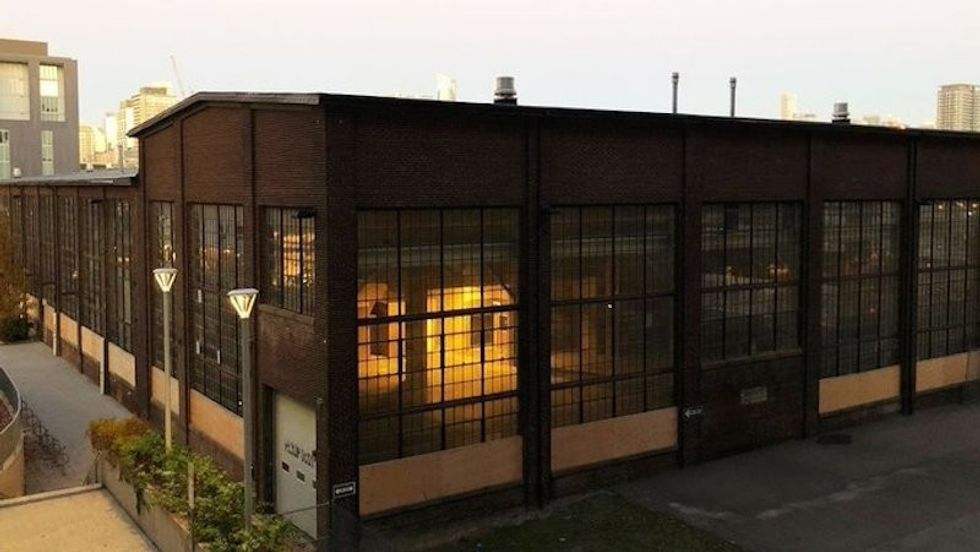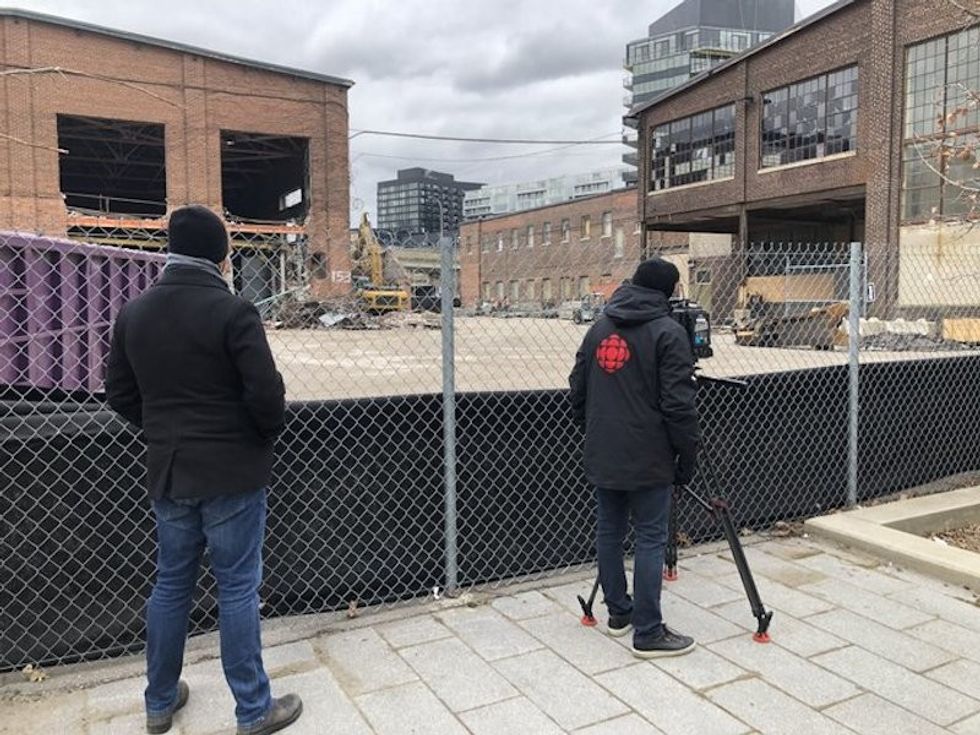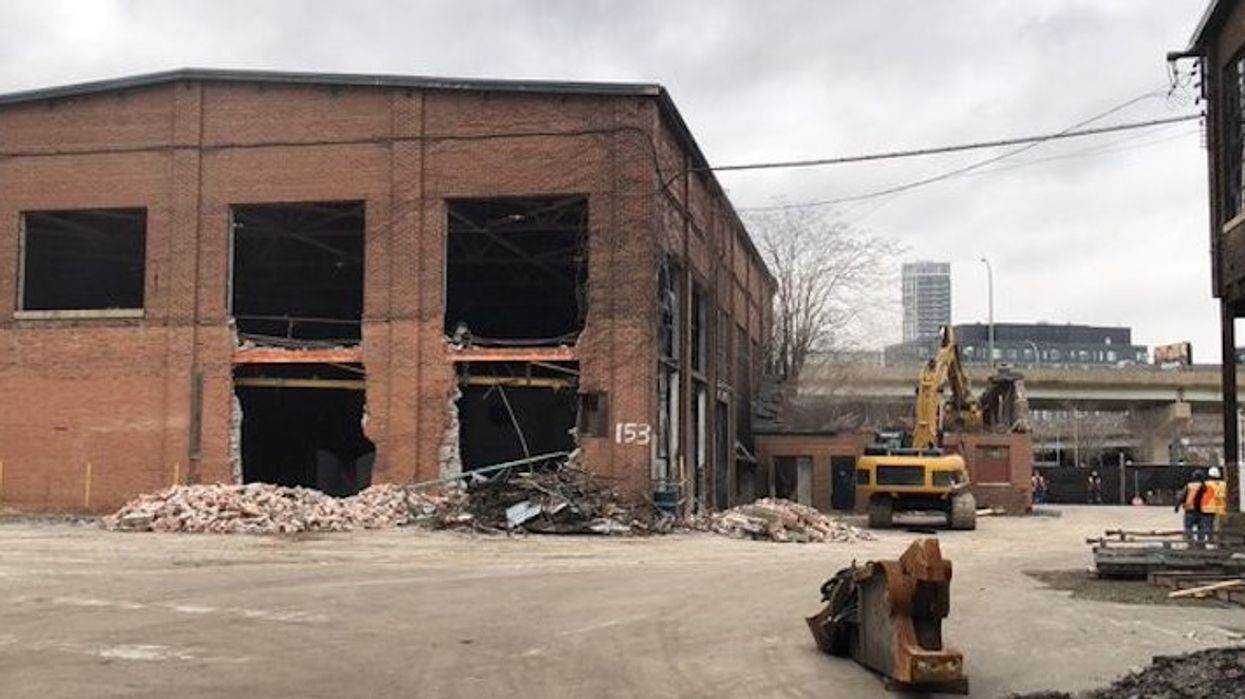Despite the bulldozers and commencement of demolition, many vocal Torontonians are continuing to urge for what’s left of the West Don Lands’ historic Foundry buildings to remain intact.
The four heritage buildings -- once home to railway equipment manufacturer Dominion Wheel and Foundries Co. some 100 years ago -- will soon become a memory, if relentless opponents and a growing online petition can’t save them. (And it doesn't look like they will.)
The provincially owned West Don Lands property sits just down the street from Toronto’s celebrated Distillery District in all of its impressively restored glory -- a glaringly apparent what-could-have-been that makes the razing of the Foundry buildings an even tougher pill to swallow for many. In a neighbourhood that often strives to protect its historic buildings and architecture in ways that aim to seamlessly incorporate the past with the present, the current situation understandably has some puzzled, leaving them to question how the demolition has possibly been approved in the first place.
It all comes down to the use of the Minister’s Zoning Order (MZO) -- something you may not have heard of until recently.
Part of Ontario’s Planning Act, an MZO is a tool that allows the Province -- currently represented by Municipal Affairs and Housing Minister Steve Clark -- to decide how a piece of land is to be used, superseding typical municipal planning and consultation processes. With its use, there is no chance for appeal from municipalities, citizens, or special interest groups like heritage or environmental advocates -- despite often-inevitable pushback.
READ: What Ford’s New COVID Measures Mean for the Ontario Construction Industry
Those who defend the use of MZOs point to their merit in accelerating the creation of more sustainable communities, affordable housing, and important infrastructure -- even if that comes at the cost of history-rich buildings or environmental protection.

Why We’re Hearing So Much About MZOs
Once a relatively unknown concept to the general public, the term “minister’s zoning order” is making its way into timely news articles and dinnertime conversations simply because it’s been used -- or, as some would argue, abused -- more frequently than ever before. In 2020, Minister Clark issued more than 35 MZOs across Ontario, many of which raised eyebrows, or were met with loud-and-clear backlash from everyone from local citizens, to politicians and environmental groups.
To put this figure into perspective, the Province issued more MZOs in the past year than the preceding Liberal government did in an entire decade.
And this hasn’t gone unnoticed.
In many cases, Minister Clark’s recent use of MZOs -- especially those ordered on environmentally vulnerable land -- were met with an impossible-to-ignore pushback that made its way into the public consciousness. The current situation in the West Don Lands is just one case of such resistance.
In Durham in late 2020, for example, the Province used an MZO to approve a major addition to the Durham Live casino that could result in the paving-over of a large area of wetland -- something that didn’t score points with local environmental advocacy groups. Meanwhile, Vaughn will also lose some of its protected wetlands after an April 2020-issued MZO (one of four in one day) that authorizes the use of the land for a large warehouse and distribution centre. In Markham, the construction of a retirement community on farmland now has the green light thanks to another 2020 MZO.
The list goes on…
Arguments for the Use of MZOs
Those in favour of the use of particular MZOs point to their necessary role in speeding up projects that make way for enriching infrastructure like affordable housing, hospitals, and community centres. Many, indeed, view the tool as a welcome and even progressive one for impacted populations and the future of the Greater Toronto Area (GTA).
“MZOs are a tool our government uses to accelerate the development of critical projects Ontarians rely on, located outside of the Greenbelt -- such as thousands of new long-term care beds, hundreds of affordable and supportive housing units, and a Made-in-Ontario PPE facility,” says Stephanie Bellotto, spokesperson for Minister Steve Clark.
As the Building Industry and Land Development association's (BILD) Justin Sherwood highlights, MZOs have always existed as a tool under the Planning Act. “They’re used in instances when guidance and direction is needed to accelerate necessary development,” says Sherwood. “A development takes time and has to go through multiple levels of approval and bureaucracy and sometimes things can get off the rails. The West Don Lands, for example, has taken an inordinate amount of time to progress.”
Sherwood points to a recent BILD municipal benchmarking study that showed many GTA municipalities are failing to hit the obligated turnaround time for approvals, in some cases, by a large period of time.
Subsequently, Bellotto and Sherwood highlight that all MZOs made by the Minister of Municipal Affairs and Housing on non-provincially owned land actually have the support of the local municipality.
“It’s important to note that all of the recent ministerial zoning orders that have come from non-provincial land (i.e. municipal land) have come forward at the request of the municipality to accelerate a stuck development process and move critical projects ahead,” says Sherwood. "Critics are up in arms, but it’s really the municipalities that asked for them. When the Province uses an MZO on land that is their jurisdiction, where the city actually very limited authority, a typically anti-development councillor who has little to no jurisdiction takes issue."
In the case of the provincially owned (key words for the government) Foundry buildings, the Province says the demolition was mandated to make way for hundreds of affordable housing units. The buildings have sat vacant since the 80s, after all.
“On October 22, 2020, the Minister of Municipal Affairs and Housing issued three MZOs in Toronto’s West Don Lands,” confirms Bellotto. “The Minister’s Parliamentary Assistant for Housing informed the Ontario Legislature in November, of the government’s intention to leverage surplus provincially-owned properties to accelerate the creation of nearly 1,000 new affordable units and 17,000 square feet of new community space – which will help Toronto achieve their affordable housing targets.”
The MZO, she says, was also posted publicly on the Environmental Registry of Ontario.
"We have to wake up to our housing supply and affordability problem. We need to build more supply faster," says Sherwood. "That requires a cultural shift in how we think about development."

Arguments Against the Use of MZOs
The passionate arguments against the use of MZOs range from everything from lack of public consultation, to a disregard for the protection of both heritage sites and environmentally sensitive spaces. In the case of the Lower Don Lands, vocal opponents like Suze Morrison, NDP MPP for Toronto Centre, Kristyn Wong-Tam, City Councillor for Ward 13, and Toronto's Chief Planner Gregg Lintern have publicly slammed the MZO, saying there hasn’t been proper public consultation or communication about the development.
“Consulting with the community is a necessary step in building the social license for a project to move forward without opposition. Ultimately, we’d like to see the City of Toronto and residents of the West Don Lands consulted about how this land should be used,” says Morrison. “The existing heritage buildings and new affordable homes can work hand-in-glove to create a beautiful space that can be home to families for generations to come.”
Local organizations like Corktown and the International Resource Centre for Performing Arts have proposed and advocated that the Foundry buildings be converted into affordable housing, a music store, performance space, a restaurant, a community space, plus more. But now, their big idea appears to be relegated to a pipe dream.
Meanwhile, the government has yet to release a public plan for the West Don Lands site, and tension is growing both on and offline.
"I strongly support getting on with building affordable housing in our city and across Ontario,” says Toronto Mayor John Tory of the site’s MZO. “But the province has begun this demolition without providing a clear plan to the City or the neighbourhood on the manner in which it intends to build affordable housing on its property.”
For critics, this lack of a plan or public development application undermines an alleged sense of urgency to create the nearly 1,000 much-needed affordable housing units promised. “Building affordable housing should be a priority of all governments right now and we should all be committed to doing it as quickly as possible while still consulting with local communities in a timely manner since any new development, good as it may be, will have an impact on existing communities,” says Mayor Tory.
Tory acknowledges that there are precedents where the MZO works when we all work together cooperatively.
"The City itself has successfully requested Ministerial Zoning Orders from the province in order to get affordable housing built quickly on other sites," says Tory. "These orders, secured in the spirit of cooperation, have led to modular housing sites getting built in a matter of months and will help us move forward with several Rapid Housing initiatives funded by the Government of Canada. These are good examples of how the process should work and how it will lead to more affordable housing options."
In theory, that’s how it’s supposed to work.
“Just because an MZO is used, there’s still a lot of processes and consultation before the development can occur,” assures BILD's Sherwood. And Tory says he's committed to finding a solution to facilitate such a situation. "I have reached out to Minister Clark's office and urged him to respond to concerns raised by the community, the local councillor, the Chief Planner, and myself," says Mayor Tory. "This would include more transparent examination of heritage issues including the making public of existing provincial heritage studies to help us all to know more."
In the meantime, the reassurance is that the Foundry's storied past won’t be forgotten.
“Alongside affordable housing and community space, heritage elements will inform the design of any new buildings on the site,” says Bellotto. For some, however, this isn’t a compromise at all.
So, the fight for the Foundry buildings continues -- as does the fight to understand the appropriate use of MZOs in general.





















